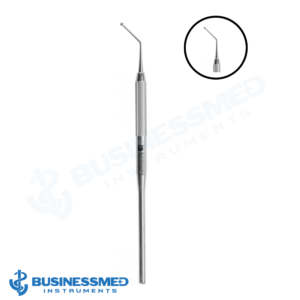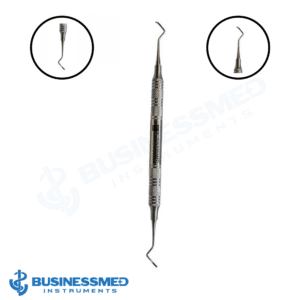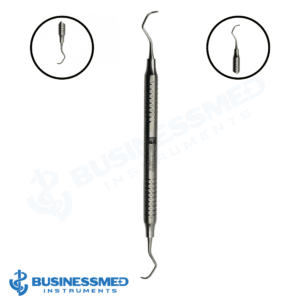Showing all 10 results
Dental Explorers – Types, Uses & Diagnostic Insights
At BusinessMed Instruments, our dental explorers are precision diagnostic tools crafted to help clinicians detect caries, assess restoration margins, and locate calculus deposits. These instruments provide tactile sensitivity essential for identifying surface irregularities, particularly in areas difficult to visualize. While sharp explorers have traditionally been used for caries detection, modern guidelines recommend gentle techniques to avoid disrupting early enamel lesions.
Types of Dental Explorers
No. 23 Explorer (Shepherd’s Hook)
Features a sickle-shaped, sharp tip ideal for detecting occlusal caries and examining restoration margins.
Preferred for use in fissures and pit areas where decay commonly begins.
11/12 Double-Ended Explorer
Equipped with mirror-image working ends, designed for periodontal and subgingival assessments.
Offers excellent tactile control, making it the choice for identifying calculus deposits.
3CH / Pigtail (DG-16) Explorer
Multiple curves allow safe access to interproximal contacts without traumatizing soft tissues.
Widely used in endodontics for locating canal orifices.
Specialized Explorers
Abou-Rass Apical Burnishers & Explorers: Designed for apical sealing and long-shank access in endodontic cases.
Endodontic DG16 Variants: Used for canal location with optimal reach and precision.
Products:
Explorer vs. Probe
Explorers: Feature sharp tips for tactile detection of caries and irregularities.
Probes: Have blunt, graduated tips designed to measure pocket depths safely.
Modern best practices recommend light strokes and minimal pressure to prevent damage to early caries or soft enamel.
Key Features to Look For
High-grade stainless steel: Ensures longevity, corrosion resistance, and autoclavability.
Ergonomic handles: Ribbed or knurled for better grip and reduced hand fatigue.
Precision tips: Available in sharp, blunted, or double-ended styles for varied applications.
ISO/CE certification: Guarantees quality and sterilization compliance.
Clinical Use Cases
Caries detection on occlusal, pit, and fissure surfaces.
Assessment of restoration margins for overhangs or defects.
Calculus detection during periodontal exams.
Endodontic canal location and apical burnishing.
Technique Tip: Use only the last 1 mm of the tip with feather-light, multidirectional strokes to enhance sensitivity while minimizing enamel risk.
Comparison Table
| Explorer Type | Primary Use | Key Benefit |
|---|---|---|
| No. 23 Shepherd’s Hook | Occlusal caries & restoration check | Sharp detection in fissures |
| 11/12 Double-Ended | Supra & subgingival calculus probing | Balanced for periodontal exams |
| 3CH / Pigtail (DG-16) | Interproximal & canal detection | Safe in tight spaces, endodontic use |
| Apical Burnishers | Endodontic sealing & exploration | Long shank for apical access |
FAQs
Q1. Should I use a sharp or blunt explorer for caries detection?
A sharp explorer offers better tactile feedback, but use it gently to avoid damaging enamel.
Q2. What’s the difference between 11/12 and No. 23 explorers?
The 11/12 is primarily for periodontal calculus detection, while No. 23 targets occlusal caries.
Q3. Can explorers damage enamel?
Improper technique with sharp explorers can harm remineralizing enamel; feather-light strokes are advised.
Q4. Which explorer is best for endodontics?
DG-16 and Abou-Rass explorers are ideal for canal location and apical burnishing.
Related Endodontic Categories
Conclusion & Call-to-Action
Selecting the right dental explorer ensures accurate diagnostics, gentle tactile assessment, and enhanced clinical outcomes.
👉 Contact Us to inquire about bulk pricing or product customization.










